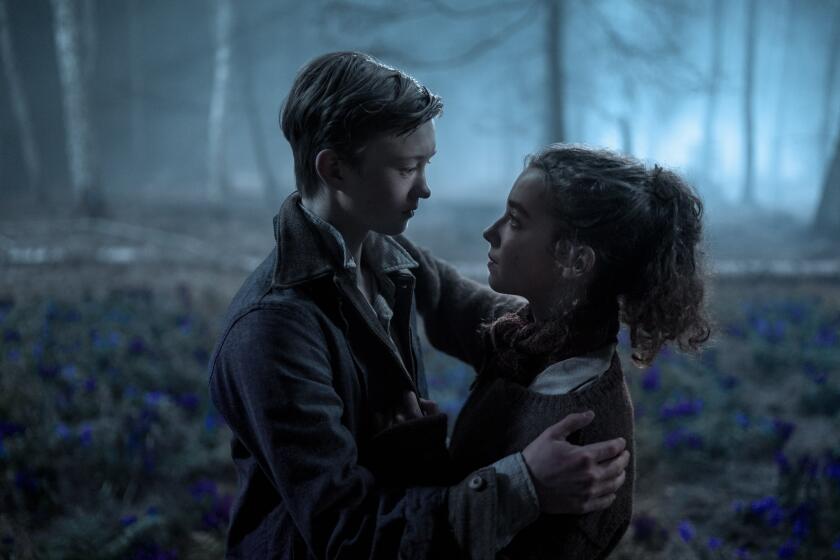MOVIE REVIEW : Raging Emotions, Uncommon Restraint : Martin Scorsese’s beautifully done adaptation of Edith Wharton’s ‘Age of Innocence’ is polished, cinematic--and a bit distant.
Imagine a society where any love at all is a love that dares not speak its name. Where proper form is everything, women are nothing, and emotions are so rigidly repressed that the unbuttoning of a glove can be a breathtakingly sensual moment. A world “balanced so precariously its harmony could be shattered by a whisper.” And then imagine Martin Scorsese putting it all on film.
This was the problematic setup for “The Age of Innocence” (selected theaters), based on Edith Wharton’s Pulitzer Prize-winning novel of New York society in the 1870s. Skeptics said that the visceral director who made “Taxi Driver,” “Raging Bull” and “Cape Fear,” the man who specialized in characters who never suppressed an emotion in their lives, was not an ideal choice to take on one of the great romantic novels of the 20th Century, a love story of surpassing delicacy and almost agonizing restraint.
But just as the Wharton novel surprises by its velvet-gloved power, so Scorsese impresses by how masterfully he has come up to the challenge. His “Age of Innocence” (co-scripted with Jay Cocks) is a beautifully done adaptation of the novel, polished, elegant and completely cinematic. It is also a bit distant, a film that doesn’t wear its feelings on its sleeve, but given the effects it’s after, that would be counterproductive.
Looked at from another point of view, there is little to be surprised at about the director’s success here. For a lesser-known Scorsese has always existed alongside the more celebrated one: the student of film history, the zealot for preservation, the champion of pictorial directors like Michael Powell and Luchino Visconti, whose joint influence on this strikingly visual film is noticeable.
Aside from the expected potent support from cinematographer Michael Ballhaus and editor Thelma Schoonmaker, both Scorsese regulars, the director has the advantage here of a cast headlined by Daniel Day-Lewis, Michelle Pfeiffer and Winona Ryder and chosen from top to bottom with exceptional shrewdness.
Day-Lewis plays Newland Archer, lawyer, dilettante and a pillar of proper society in 1870s Manhattan. Engaged to May Welland (Ryder), the most eligible as well as the most giggly young woman around, Newland takes the nature of the social order he is a part of more or less for granted until Ellen Olenska (Pfeiffer) enters his life.
Actually, re-enters is more like it, for Newland and Ellen were childhood friends. But Ellen’s family moved to Europe, where she eventually married Count Olenska, an apparently dissolute type whose mistreatment has led Ellen to leave him behind and return to what she hopes will be the safety of the city she grew up in.
Ellen is also May Welland’s cousin, and, as an unattached woman soon to be related by marriage, partly Newland’s responsibility. So when he hears malicious gossips like Larry Lefferts (Richard E. Grant) starting to target her, he chivalrously moves, much to May’s satisfaction, to act protectively toward his old friend.
But Ellen, spirited, independent and unbound by convention, is a woman unlike any Newland has known. When, for instance, with typical mock sophistication he archly tells her he loves his fiancee as much as one can, she replies with disturbing directness, “Do you think there’s a limit?”
And, in fact, the more Newland sees Ellen, the more he starts to feel stifled by the society whose suppression of women he took for granted and the less he feels sure about his love for May. And when as an attorney and Ellen’s friend he is called on by the family to talk her out of her plans for a scandal-provoking divorce from the count, the intensity of his feelings gradually comes into sharper focus.
But no more than gradually, for one of the ways Scorsese and Cocks’ script is faithful to the novel’s nuances is by demonstrating how imperceptibly society’s strictures and his own qualms turn Newland into “a prisoner in the center of an armed camp.” Essential in setting and keeping this tone is the decision to have Joanne Woodward contribute a letter-perfect voice-over narration that catches Wharton’s witheringly ironic sensibility.
And it is not just the verbal tone that has been preserved, but also the visual one. Like the old master he’s become, Scorsese (helped by production designer Dante Ferretti and all kinds of experts from a Table Decoration Consultant to a Chef, 19th Century Meals) has re-created a bygone New York with special, almost tactile attention paid to details like the way a cigar end was cut or how clothing was worn. For Newland Archer’s world is a world of things, a place where creature comforts inhibit and suffocate life as much as ease it.
In finding actors to fill this world, Scorsese and casting director Ellen Lewis have been careful with even the smallest roles to select those, ranging from Miriam Margolyes’ amusing Mrs. Manson Mingott to Stuart Wilson’s audacious Julius Beaufort, who seem at ease in it. And he has enlivened the telling with an overall cinematic elan and a range of effects including a by-now trademark Steadicam sequence and expressive use of the old-fashioned iris close.
Finally, however, the story of “The Age of Innocence” (rated PG) is the story of Newland, Ellen and May. Winona Ryder captures May’s genteel self-satisfaction exquisitely, and Pfeiffer, though readers of the book will wish she was rather more mysterious, is especially effective in the film’s most emotional scenes.
It is Day-Lewis, who couldn’t be more different here than he was in “The Last of the Mohicans,” who appears to greatest effect. He is the ideal Newland, a young man whose sensitivity and poetic indecision are reflected in his bright, handsome face. Longing, loss and an almost indescribable poignancy cross that face as well, signposts of emotions that, both Wharton and Scorsese know, are all the more affecting for being inarticulate and unexpressed.
‘The Age of Innocence’ Daniel Day-Lewis: Newland Archer Michelle Pfeiffer: Ellen Olenska Winona Ryder: May Welland Richard E. Grant: Larry Lefferts Stuart Wilson: Julius Beaufort Miriam Margolyes: Mrs. Mingott Jonathan Pryce: Riviere
A Cappa/De Fina production, released by Columbia Pictures. Director Martin Scorsese. Producer Barbara De Fina. Screenplay Jay Cocks & Scorsese. Cinematographer Michael Ballhaus. Editor Thelma Schoonmaker. Costumes Gabriella Pescucci. Music Elmer Bernstein. Production design Dante Ferretti. Art director Speed Hopkins. Set decorators Robert J. Franco, Amy Marshall. Running time: 2 hours, 13 minutes.
MPAA-rated PG (thematic elements and some mild language).
More to Read
Only good movies
Get the Indie Focus newsletter, Mark Olsen's weekly guide to the world of cinema.
You may occasionally receive promotional content from the Los Angeles Times.











